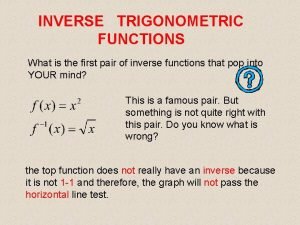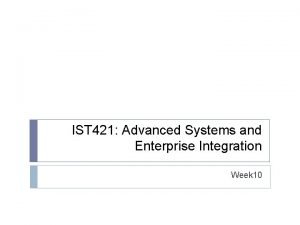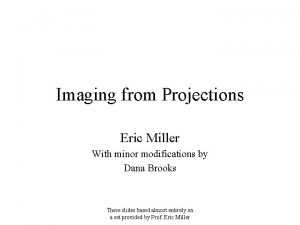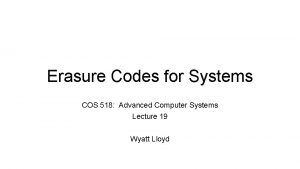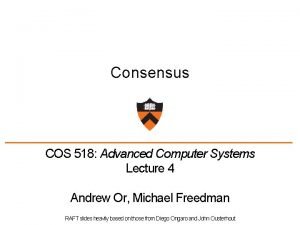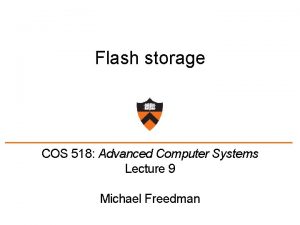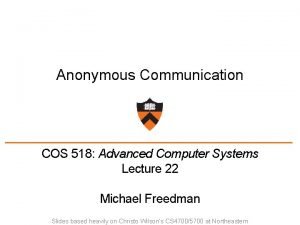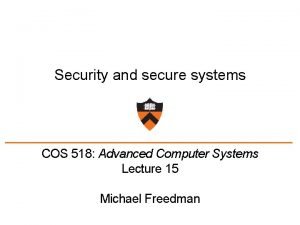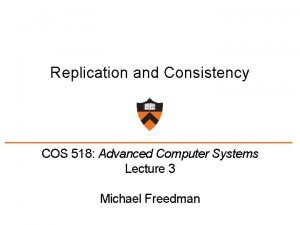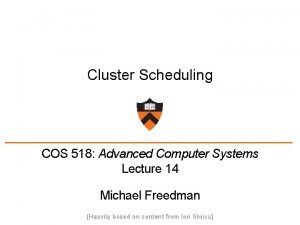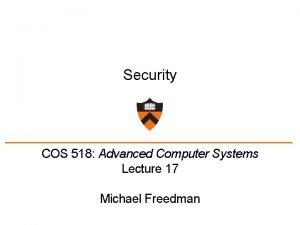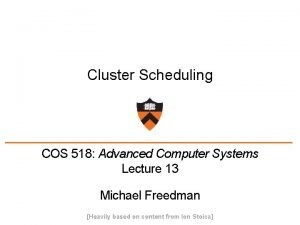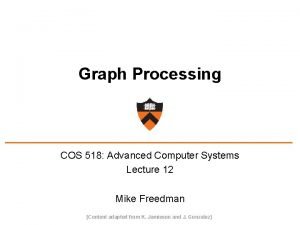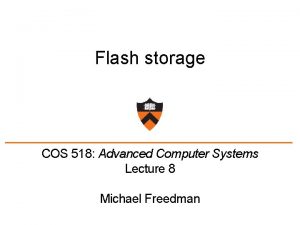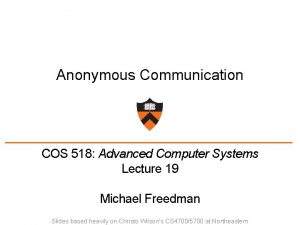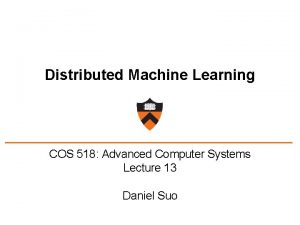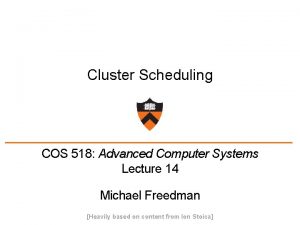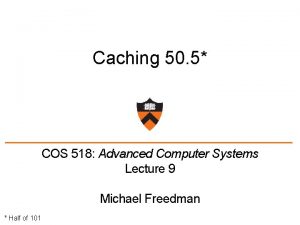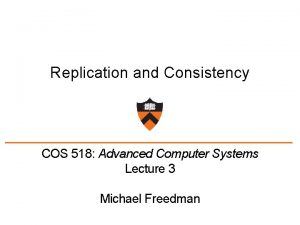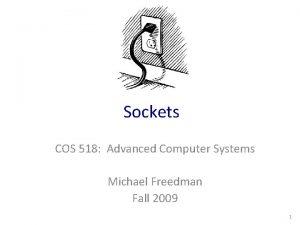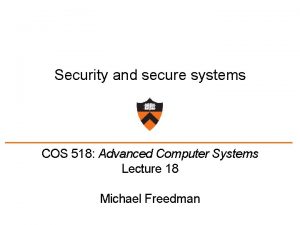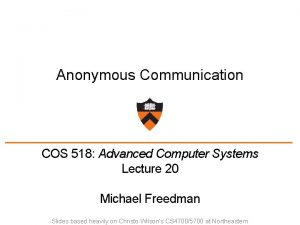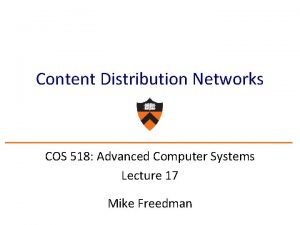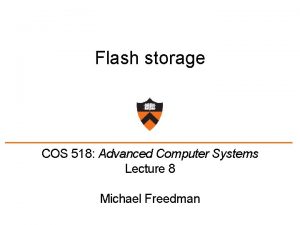Erasure Codes for Systems COS 518 Advanced Computer








































![f 4: Facebook’s Warm BLOB Storage System [OSDI ‘ 14] Subramanian Muralidhar*, Wyatt Lloyd*ᵠ, f 4: Facebook’s Warm BLOB Storage System [OSDI ‘ 14] Subramanian Muralidhar*, Wyatt Lloyd*ᵠ,](https://slidetodoc.com/presentation_image_h/f23c2c5937ceef133791f7bbd27c4a17/image-41.jpg)





![Background: Haystack [OSDI’ 10] • Volume is a series of BLOBs • In-memory index Background: Haystack [OSDI’ 10] • Volume is a series of BLOBs • In-memory index](https://slidetodoc.com/presentation_image_h/f23c2c5937ceef133791f7bbd27c4a17/image-47.jpg)
















- Slides: 63

Erasure Codes for Systems COS 518: Advanced Computer Systems Lecture 14 Michael Freedman Slides originally by Wyatt Lloyd

Things Fail, Let’s Not Lose Data • Replication • Store multiple copies of the data • Simple and very commonly used! • But, requires a lot of extra storage • Erasure coding • Store extra information we can use to recover the data • Fault tolerance with less storage overhead

Erasure Codes vs Error Correcting Codes • Error correcting code (ECC): • Protects against errors is data, i. e. , silent corruptions • Bit flips can happen in memory -> use ECC memory • Bits can flip in network transmissions -> use ECCs • Erasure code: • Data is erased, i. e. , we know it’s not there • Cheaper/easier than ECC • Special case of ECC • What we’ll discuss today and use in practice • Protect against errors with checksums

Erasure Codes, a simple example w/ XOR A B A⊕B

Erasure Codes, a simple example w/ XOR A B A⊕B

Erasure Codes, a simple example w/ XOR A A B = B A⊕B ⊕ A⊕B

Reed-Solomon Codes (1960) • N data blocks • K coding blocks • M = N+K total blocks • Recover any block from any N other blocks! • Tolerates up to K simultaneous failures • Works for any N and K (within reason)

Reed-Solomon Code Notation • N data blocks • K coding blocks • M = N+K total blocks • RS(N, K) • (10, 4): 10 data blocks, 4 coding blocks • f 4 uses this, FB HDFS for data warehouse does too • Will also see (M, N) notation sometimes • (14, 10): 14 total blocks, 10 data blocks, (4 coding blocks)

Reed-Solomon Codes, How They Work • Galois field arithmetic is the secret sauce • Details aren’t important for us • See “J. S. Plank. A tutorial on Reed-Solomon coding for faulttolerance in RAID-like systems. Software—Practice & Experience 27(9): 995– 1012, September 1997. ”

Reed-Solomon (4, 2) Example A B C D 1 2

Reed-Solomon (4, 2) Example A B C D 1 2

Reed-Solomon (4, 2) Example A A B = B C + C D + D 1 + 1 2

Reed-Solomon (4, 2) Example A A B = B C + D 2 1 C + D + 1 = = = A = + 2

Erasure Codes Save Storage • Tolerating 2 failures • 3 x replication = ___ storage overhead

Erasure Codes Save Storage • Tolerating 2 failures • 3 x replication = 3 x storage overhead • RS(4, 2) = ___ storage overhead

Erasure Codes Save Storage • Tolerating 2 failures • 3 x replication = 3 x storage overhead • RS(4, 2) = (4+2)/4 = 1. 5 x storage overhead

Erasure Codes Save Storage • Tolerating 2 failures • 3 x replication = 3 x storage overhead • RS(4, 2) = (4+2)/4 = 1. 5 x storage overhead • Tolerating 4 failures • 5 x replication = 5 x storage overhead • RS(10, 4) = ___ storage overhead

Erasure Codes Save Storage • Tolerating 2 failures • 3 x replication = 3 x storage overhead • RS(4, 2) = (4+2)/4 = 1. 5 x storage overhead • Tolerating 4 failures • 5 x replication = 5 x storage overhead • RS(10, 4) = (10+4)/10 = 1. 4 x storage overhead • RS(100, 4) = ___ storage overhead

Erasure Codes Save Storage • Tolerating 2 failures • 3 x replication = 3 x storage overhead • RS(4, 2) = (4+2)/4 = 1. 5 x storage overhead • Tolerating 4 failures • 5 x replication = 5 x storage overhead • RS(10, 4) = (10+4)/10 = 1. 4 x storage overhead • RS(100, 4) = (100+4)/100 = 1. 04 x storage overhead

What’s the Catch?

Catch 1: Encoding Overhead • Replication: • Just copy the data • Erasure coding: • Compute codes over N data blocks for each of the K coding blocks

Catch 2: Decoding Overhead • Replication • Just read the data • Erasure Coding

Catch 2: Decoding Overhead • Replication • Just read the data • Erasure Coding • Normal case is no failures -> just read the data! • If there are failures • Read N blocks from disks and over the network • Compute code over N blocks to reconstruct the failed block

Catch 3: Updating Overhead • Replication: • Update the data in each copy • Erasure coding • Update the data in the data block • And all of the coding blocks

Catch 3’: Deleting Overhead • Replication: • Delete the data in each copy • Erasure coding • Delete the data in the data block • Update all of the coding blocks

Catch 4: Update Consistency • Replication: • Erasure coding

Catch 4: Update Consistency • Replication: • Consensus protocol (Paxos!) • Erasure coding • Need to consistently update all coding blocks with a data block • Need to consistently apply updates in a total order across all blocks • Need to ensure reads, including decoding, are consistent

Catch 5: Fewer Copies for Reading • Replication • Read from any of the copies • Erasure coding • Read from the data block • Or reconstruct the data on fly if there is a failure

Catch 6: Larger Min System Size • Replication • Need K+1 disjoint places to store data • e. g. , 3 disks for 3 x replication • Erasure coding • Need M=N+K disjoint places to store data • e. g. , 14 disks for RS(10, 4) replication

What’s the Catch? • Encoding overhead • Decoding overhead • Updating overhead • Deleting overhead • Update consistency • Fewer copies for serving reads • Larger minimum system size

Different codes make different tradeoffs • Encoding, decoding, and updating overheads • Storage overheads • Best are “Maximum Distance Separable” or “MDS” codes where K extra blocks allows you to tolerate any K failures • Configuration options • Some allow any (N, K), some restrict choices of N and K • See “Erasure Codes for Storage Systems, A Brief Primer. James S. Plank. Usenix ; login: Dec 2013” for a good jumping off point • Also a good, accessible resource generally

Erasure Coding Big Picture • Huge Positive • Fault tolerance with less storage overhead! • Many drawbacks • Encoding overhead • Decoding overhead • Updating overhead • Deleting overhead • Update consistency • Fewer copies for serving reads • Larger minimum system size

Let’s Improve Our New Hammer!

Erasure Coding Big Picture • Huge Positive • Fault tolerance with less storage overhead! • Many drawbacks • Encoding overhead • Decoding overhead • Updating overhead • Deleting overhead • Update consistency • Fewer copies for serving reads • Larger minimum system size Immutable data

Erasure Coding Big Picture • Huge Positive • Fault tolerance with less storage overhead! • Many drawbacks • Encoding overhead • Decoding overhead • Updating overhead • Deleting overhead • Update consistency • Fewer copies for serving reads • Larger minimum system size Immutable data

Erasure Coding Big Picture • Huge Positive • Fault tolerance with less storage overhead! • Many drawbacks • Encoding overhead • Decoding overhead • Updating overhead • Deleting overhead • Update consistency • Fewer copies for serving reads • Larger minimum system size Immutable data Storing lots of data (when storage overhead actually matters this is true)

Erasure Coding Big Picture • Huge Positive • Fault tolerance with less storage overhead! • Many drawbacks • Encoding overhead • Decoding overhead • Updating overhead • Deleting overhead • Update consistency • Fewer copies for serving reads • Larger minimum system size Immutable data Storing lots of data (when storage overhead actually matters this is true)

Erasure Coding Big Picture • Huge Positive • Fault tolerance with less storage overhead! • Many drawbacks • Encoding overhead • Decoding overhead • Updating overhead • Deleting overhead • Update consistency • Fewer copies for serving reads • Larger minimum system size Data is stored for a long time after being written Immutable data Storing lots of data (when storage overhead actually matters this is true)

Erasure Coding Big Picture • Huge Positive • Fault tolerance with less storage overhead! • Many drawbacks • Encoding overhead • Decoding overhead • Updating overhead • Deleting overhead • Update consistency • Fewer copies for serving reads • Larger minimum system size Low read rate Data is stored for a long time after being written Immutable data Storing lots of data (when storage overhead actually matters this is true)

Erasure Coding Big Picture • Huge Positive • Fault tolerance with less storage overhead! • Many drawbacks • Encoding overhead • Decoding overhead • Updating overhead Low read rate Data is stored for a long time after being written • Deleting overhead • Update consistency • Fewer copies for serving reads • Larger minimum system size Immutable data Storing lots of data (when storage overhead actually matters this is true)
![f 4 Facebooks Warm BLOB Storage System OSDI 14 Subramanian Muralidhar Wyatt Lloydᵠ f 4: Facebook’s Warm BLOB Storage System [OSDI ‘ 14] Subramanian Muralidhar*, Wyatt Lloyd*ᵠ,](https://slidetodoc.com/presentation_image_h/f23c2c5937ceef133791f7bbd27c4a17/image-41.jpg)
f 4: Facebook’s Warm BLOB Storage System [OSDI ‘ 14] Subramanian Muralidhar*, Wyatt Lloyd*ᵠ, Sabyasachi Roy*, Cory Hill*, Ernest Lin*, Weiwen Liu*, Satadru Pan*, Shiva Shankar*, Viswanath Sivakumar*, Linpeng Tang*⁺, Sanjeev Kumar* *Facebook Inc. , ᵠUniversity of Southern California, ⁺Princeton University 1

BLOBs@FB Cover Photo Profile Photo Immutable & Unstructured Feed Photo Diverse A LOT of them!! Feed Video

510 X HOT DATA Normalized Read Rates 590 X WARM DATA Photo Video Data cools off rapidly 98 X < 1 Days 68 X 1 Day 30 X 16 X 1 Week 14 X 6 X 1 Month 7 X 2 X 3 Months 1 X 1 X 1 Year

Host Disk failures 39 DC Rack failures Handling failures DATACENTER RACKS HOST 1. 2 Replication: * 3 = 3. 6

Handling load HOST 6 Reduce space usage AND Not compromise reliability

Background: Data serving User Requests • CDN protects storage • Router abstracts storage Writes Web Servers Reads CDN • Web tier adds business logic Router BLOB Storage
![Background Haystack OSDI 10 Volume is a series of BLOBs Inmemory index Background: Haystack [OSDI’ 10] • Volume is a series of BLOBs • In-memory index](https://slidetodoc.com/presentation_image_h/f23c2c5937ceef133791f7bbd27c4a17/image-47.jpg)
Background: Haystack [OSDI’ 10] • Volume is a series of BLOBs • In-memory index Header BID 1: Off BLOB 1 BID 2: Off Footer Header BLOB 1 Footer Volume BIDN: Off In-Memory Index

Introducing f 4: Haystack on cells Rack Data+Index Cell Compute

Data splitting 10 G Volume Reed Solomon Encoding 4 G parity Stripe 2 Stripe 1 BLOB 1 RS BLOB 2 BLOB 4 BLOB 5 BLOB 4 BLOB 2 BLOB 8 BLOB 10 BLOB 11 BLOB 7 BLOB 3 RS BLOB 6 BLOB 9 => =>

Data placement 10 G Volume Stripe 1 4 G parity Stripe 2 RS RS Cell with 7 Racks • Reed Solomon (10, 4) is used in practice (1. 4 X) • Tolerates 4 racks ( 4 disk/host ) failures

Reads Router User Request Index Read Index Storage Nodes Data Read Compute Cell • 2 -phase: Index read returns exact physical location of BLOB

Reads under cell-local failures Router User Request Index Read Index Storage Nodes Data Read Decode Read Compute (Decoders) Cell • Cell-Local failures (disks/hosts/racks) handled locally

Reads under datacenter failures (2. 8 X) User Request Proxying Compute (Decoders) Cell in Datacenter 1 Compute (Decoders) Mirror Cell in Datacenter 2 2 * 1. 4 X = 2. 8 X

Cross datacenter XOR (1. 5 * 1. 4 = 2. 1 X) 67% Index Cell in Datacenter 1 33% Index Cell in Datacenter 2 Index Cross –DC index copy Cell in Datacenter 3

Reads with datacenter failures (2. 1 X) Router Index Data Read User Router Request XO R Index Read Data Read Router Index

Haystack f 4 2. 8 f 4 2. 1 3. 6 X 2. 8 X 2. 1 X Irrecoverable Disk Failures 9 10 10 Irrecoverable Host Failures 3 10 10 Irrecoverable Rack failures 3 10 10 Irrecoverable Datacenter failures Load split 3 2 2 3 X 2 X 1 X 3 -way replication RS(10, 4)

Evaluation • What and how much data is “warm”? • Can f 4 satisfy throughput and latency requirements? • How much space does f 4 save • f 4 failure resilience

Methodology • CDN data: 1 day, 0. 5% sampling • BLOB store data: 2 week, 0. 1% • Random distribution of BLOBs assumed • The worst case rates reported

Hot and warm divide 400 Reads/Sec per disk 350 HOT DATA 300 WARM DATA > 3 months f 4 < 3 months Haystack 250 200 Ph. . . 150 100 80 Reads/Sec 50 0 1 week 1 month Age 3 month 1 year

It is warm, not cold Haystack (50%) HOT DATA F 4 (50%) WARM DATA

f 4 Performance: Most loaded disk in cluster Reads/Se c Peak load on disk: 35 Reads/Sec

f 4 Performance: Latency P 80 = 30 ms P 99 = 80 ms

Summary • Facebook’s BLOB storage is big and growing • BLOBs cool down with age • ~100 X drop in read requests in 60 days • Haystack’s 3. 6 X replication over provisioning for old, warm data. • f 4 encodes data to lower replication to 2. 1 X
 Opwekking 585
Opwekking 585 Enterprise data erasure software
Enterprise data erasure software Residential school photos show grim legacy
Residential school photos show grim legacy Residential school photos legacy erasure
Residential school photos legacy erasure Erasure coding 이란
Erasure coding 이란 Nilai dari sin150o + cos 45o adalah
Nilai dari sin150o + cos 45o adalah Cos c -cos d
Cos c -cos d Bentuk sederhana dari sin160° - sin80° adalah
Bentuk sederhana dari sin160° - sin80° adalah Sen(a+b)+sen(a-b)
Sen(a+b)+sen(a-b) Schema fabula e intreccio
Schema fabula e intreccio Gli elementi del testo narrativo
Gli elementi del testo narrativo Inverse trig function calculator
Inverse trig function calculator Nilai dari 6 sin 112 5° sin 22 5° adalah
Nilai dari 6 sin 112 5° sin 22 5° adalah Tentukan nilai trigonometri sin 315°
Tentukan nilai trigonometri sin 315° Advanced fusion systems llc
Advanced fusion systems llc Advanced fueling systems
Advanced fueling systems Advanced multimedia systems
Advanced multimedia systems Advanced fluid systems
Advanced fluid systems Tom kilcer advanced ag systems
Tom kilcer advanced ag systems Advanced systems integration
Advanced systems integration Advanced embedded systems
Advanced embedded systems Projection slice theorem
Projection slice theorem Advanced cooling systems inc
Advanced cooling systems inc Ec 6009
Ec 6009 Advanced topics in computer science
Advanced topics in computer science Advanced computer graphics
Advanced computer graphics Advanced computer forensics
Advanced computer forensics Advanced computer forensics
Advanced computer forensics Fspos vägledning för kontinuitetshantering
Fspos vägledning för kontinuitetshantering Typiska drag för en novell
Typiska drag för en novell Nationell inriktning för artificiell intelligens
Nationell inriktning för artificiell intelligens Vad står k.r.å.k.a.n för
Vad står k.r.å.k.a.n för Shingelfrisyren
Shingelfrisyren En lathund för arbete med kontinuitetshantering
En lathund för arbete med kontinuitetshantering Särskild löneskatt för pensionskostnader
Särskild löneskatt för pensionskostnader Personlig tidbok fylla i
Personlig tidbok fylla i Anatomi organ reproduksi
Anatomi organ reproduksi Densitet vatten
Densitet vatten Datorkunskap för nybörjare
Datorkunskap för nybörjare Stig kerman
Stig kerman Debattinlägg mall
Debattinlägg mall Delegerande ledarstil
Delegerande ledarstil Nyckelkompetenser för livslångt lärande
Nyckelkompetenser för livslångt lärande Påbyggnader för flakfordon
Påbyggnader för flakfordon Arkimedes princip formel
Arkimedes princip formel Publik sektor
Publik sektor I gullregnens månad
I gullregnens månad Presentera för publik crossboss
Presentera för publik crossboss Jiddisch
Jiddisch Vem räknas som jude
Vem räknas som jude Klassificeringsstruktur för kommunala verksamheter
Klassificeringsstruktur för kommunala verksamheter Fimbrietratt
Fimbrietratt Claes martinsson
Claes martinsson Centrum för kunskap och säkerhet
Centrum för kunskap och säkerhet Programskede byggprocessen
Programskede byggprocessen Mat för unga idrottare
Mat för unga idrottare Verktyg för automatisering av utbetalningar
Verktyg för automatisering av utbetalningar Rutin för avvikelsehantering
Rutin för avvikelsehantering Smärtskolan kunskap för livet
Smärtskolan kunskap för livet Ministerstyre för och nackdelar
Ministerstyre för och nackdelar Tack för att ni har lyssnat
Tack för att ni har lyssnat Referatmarkering
Referatmarkering Redogör för vad psykologi är
Redogör för vad psykologi är Matematisk modellering eksempel
Matematisk modellering eksempel











